Revision Notes on Neural Control and Coordination NEET 2025 - Free PDF Download
Students who are preparing for the NEET exam should get help from our Neural Control and Coordination Class 11 notes. These notes have detailed explanations, solutions, and question-answers that clear the context of the chapter to the aspirants. You can download these revision notes without an issue and read them on your PC, smartphone, laptop or any other internet-based digital device.
So, if you have been anxious about this chapter, you can make the most of these notes to prepare well. Solve the solutions and read the chapter explanation added to the Neural Control and Coordination NEET notes. The explanation is written in simple language to better help students grasp the concept.
Note: 👉Explore Your Medical College Options with the NEET Rank and College Predictor 2025.
Access NEET Revision Notes Biology Neural Control and Coordination
Introduction
The human body is a collective functional unit which is made of several organs. The organs work in complete coordination with one another.
Organs cannot work alone because there are specific needs of every organ that need to be fulfilled and the organ itself cannot fulfil those needs.
So all organs of the human body need the support of other organs to perform their functions and thus an organ system is formed.
Coordination is the process through which two or more organs interact and help in proper functioning with each other.
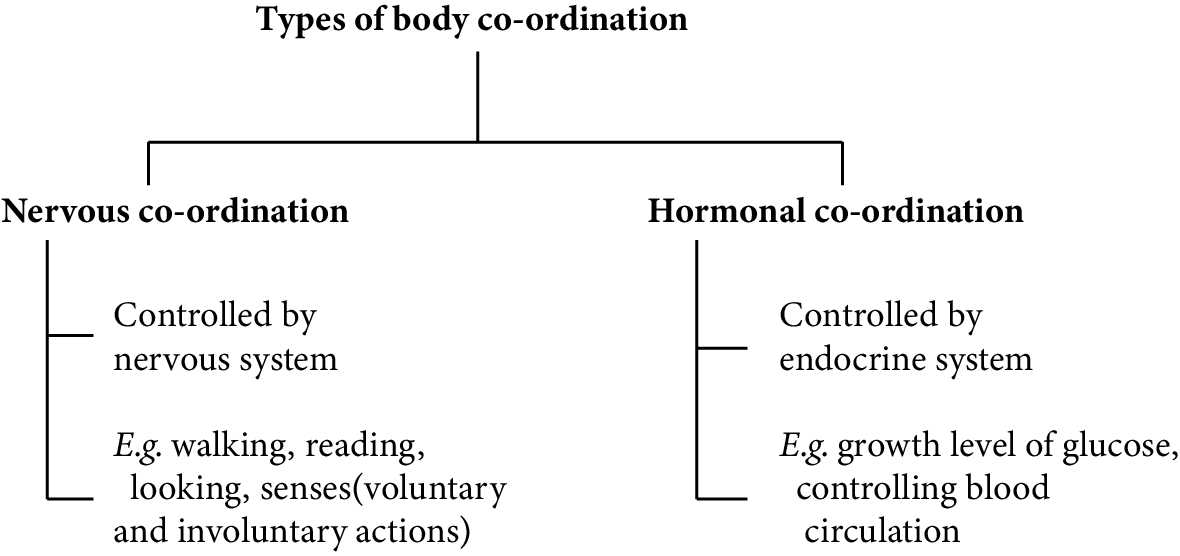
Types of Coordination Found in the Human Body
In our body, the neural system and the endocrine system jointly coordinate and integrate all the activities of the organs.
Nervous system
A neural or nervous system is defined as the system of neurons that form a network throughout the body for conducting information via electrical impulses so as to coordinate and control the activities of assorted parts as well as provide an appropriate response to both internal and external stimuli.
A stimulus is an agent, chemical or change in the external or internal environment which brings about a reaction in the organism.
The response is defined as the reaction of the organism to a stimulus.
Receptors are cells, tissues and organs which are capable of receiving particular stimuli and initiating impulses to be picked up by sensory nerves.
An impulse is an electrical current that runs along the surface of the nerve fibre for the passage of information.
Effectors are muscles, glands, tissues or cells which act in response to a stimulus received from the nervous system.
In Hydra and other cnidarians like sea anemones and jellyfish, the nervous system consists of several nerve cells linked with each other to form a sort of nerve nets in the body layer.
The neural system is better organised in insects, where a brain is present along with a number of ganglia and neural tissues.
In insects, the nervous system consists of the brain present above the pharynx and the solid double nerve cord runs backwards through the thorax and abdomen. It bears paired ganglia in the thorax as well as in the abdomen.
The vertebrates have a more developed neural system.
Structure of Nerve cell or Neuron
A neuron or nerve cell is a structural and functional unit of the nervous system that is specialised to receive, conduct and transmit impulses. It is very long, sometimes reaching 90-100 cm. A neuron has three parts- cell body, dendrites and axon. The term ‘neurites’ is used for both dendrites and axons.
1. Cell body or cyton:
It is a broad, rounded part of the neuron that contains a nucleus in the centre. It has cytoplasm and various cell organelles but centrioles are not present due to which neurons cannot divide.
The nucleus is large with a prominent nucleolus.
Endoplasmic reticulum twists around the ribosome and forms granule-like structures called Nissl's granules or Tigroid body. It is the centre of protein synthesis and has iron.
Many small fibrils are found in the cytoplasm called neurofibrils. These neurofibrils help in internal conduction in the cyton.
2. Dendrites:
It is a small cell process. It has fine branches called dendrites.
Some receptors are found on the dendrites, so dendrites receive the stimuli
The presence of Nissl’s granules and neurofibrils is also seen in dendrons.
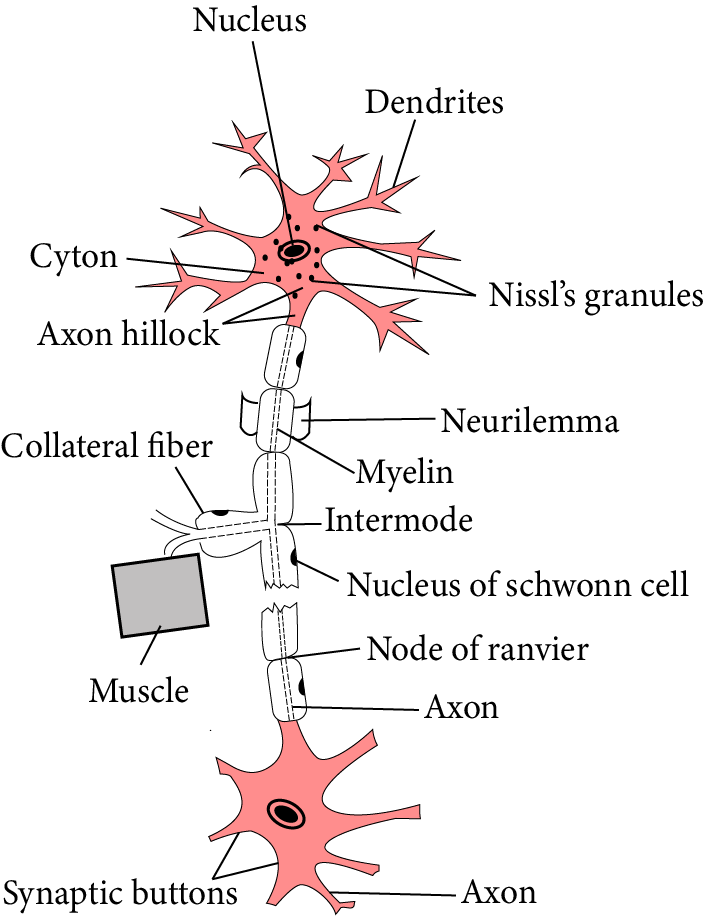
Structure of Nerve Cell or Neuron
3. Axon:
It is the longest cell process of a cyton. Axons contain axoplasm.
Nissl’s granules are absent in the axoplasm. It contains only neurofibrils and mitochondria.
Axon is covered by axolemma. And the part of the cyton where the axon arises is called the axon hillock.
The terminal end of the axon is branched in button-shaped branches which are called telodendria.
More mitochondria are found in the telodendria.
Axon is the functional part of the nerve cell, thus the term nerve fibre usually refers to the axon.
Axon is covered by phospholipids which are called medulla which further is covered by a thin cell membrane known as neurilemma or sheath of Schwann cells.
Schwann cells take part in the deposition of the myelin sheath.
Myelin sheath acts as an insulator and prevents leakage of ions and conserves axon’s energy.
Types of Neurons:
Depending on the shape, number and arrangement of the processes arising from the cyton, three types of neurons are recognised:
unipolar neuron where the cyton is more or less spherical and has a single process. Such neurons are found usually in the embryonic stage.
The bipolar neuron where the cyton is spindle-shaped and has two processes, one at each end. Such neurons are found in the sense organs like the ear and retina of the eye.
The multipolar neuron where the cyton has several processes, one of which is long and forms the axon. Such neurons are found in the cerebral cortex.
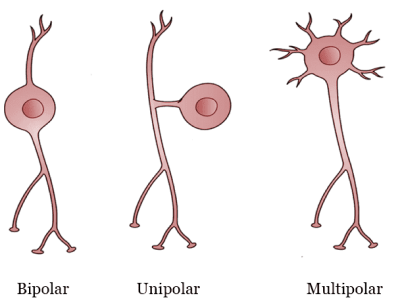
Unipolar, Bipolar, and Multipolar Neurons
Apolar/Non-polar neuron: Cell processes are either absent or present. But if present then they are not differentiated in axons and dendrites. Nerve impulse radiates in all directions, e.g., Hydra, cells of the retina.
Pseudo unipolar: In this type, the cell has only an axon but a small process develops from the axon which acts as a dendron, e.g., Dorsal root ganglia of the spinal cord.

Pseudounipolar Neuron
Depending on the function; three types of neurons are recognised :
Sensory or Receptor neuron: Sensory neurons receive stimuli by their dendrites and transmit impulses towards the central nervous system through their axon and are found in sense organs.
Motor or Effector neuron: The dendrites of these neurons synapse with axons of sensory neurons in the central nervous system. These send impulses from the central nervous system towards effectors, in response to stimuli.
Relay or Connector neuron: These serve as links between sensory and motor neurons for distant relay of nerve impulses. These are found in the central nervous system.
Generation and Conduction of nerve impulse
Neurons have membranes which are in a polarised state so are excited in nature. Different types of ion channels are present on the neural membrane. These ion channels are selectively permeable to different ions.
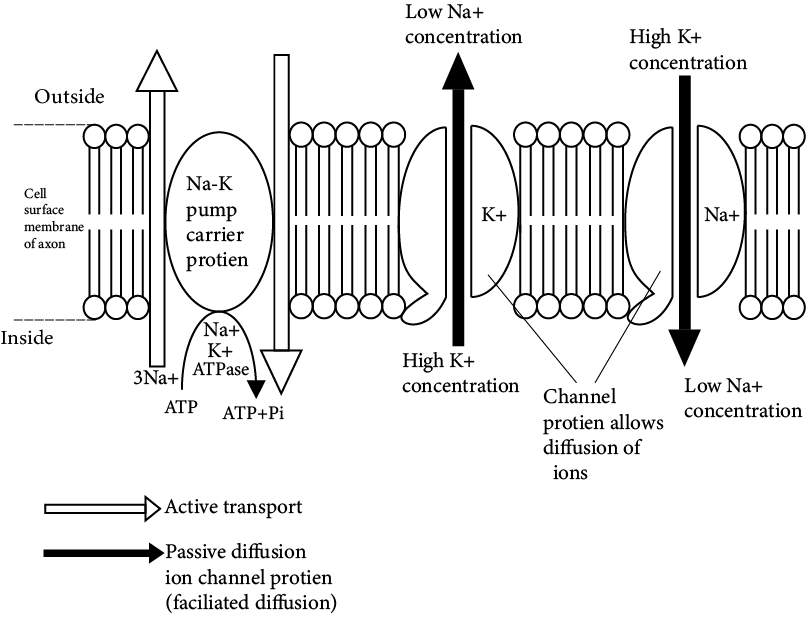
Membrane Potential Across Nerve Cell during a Nerve Impulse
Resting Membrane Potential in Resting Phase
The potential difference exists as such that it is negative inside the cell with respect to the outside. This type of membrane is said to be polarised.
The potential difference across the membrane at rest is called the resting membrane potential (RMP) and this is about – 70 mV.
The resting potential is maintained by active transport, and passive diffusion of ions also contributes toward resting potential.
Resting membrane potential is maintained by the active transport of ions against their electrochemical gradient by the sodium-potassium pump. These are carrier proteins located in the cell surface membrane. They are driven by the energy supplied by ATP and couple the removal of three sodium ions (3 Na+) from the axon with the uptake of two potassium ions (2K+).
Action Potential in Exciting Stage
The action potential is another name for nerve impulses. This is generated by a change in the sodium ion channels. These channels, and some of the potassium ion channels, are known as voltage-gated channels which means these can be opened or closed with a change in voltage. In the resting state, these channels are closed due to the binding of Ca++.
An action potential is generated by a sudden opening of the sodium gates. The opening of gates increases the permeability of the axon membrane to sodium ions which enter by diffusion.
This increases the number of positive ions inside the axon. A change of –10mV in potential difference from RMP through influx is sufficiently significant to trigger a rapid influx of Na+ ions leading to the generation of an action potential. This change of –10 mV is called the threshold stimulus.
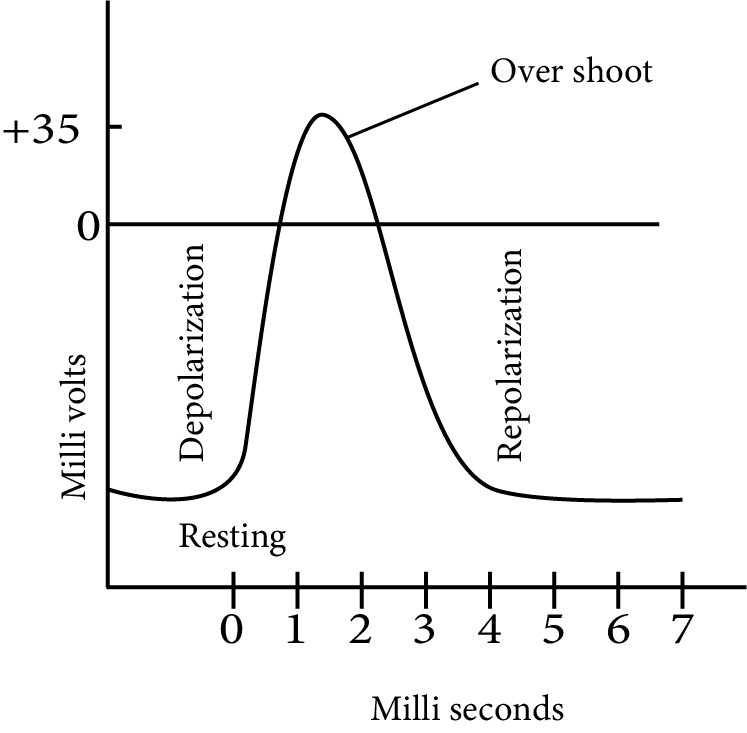
Action Potential Graph during Stimulus
At the point where the membrane is completely depolarised due to the rapid influx of Na+ ions, the negative potential is first cancelled out and becomes 0. This axolemma is called an excited membrane or depolarised membrane. Due to further entry of Na+, the membrane potential shoots beyond zero and becomes positive up to +30 to +45mV. This overshoot peak corresponds to a maximum concentration of sodium inside the axon. This potential is called the action potential. In this state, the inner surface of the axolemma becomes positively charged and the outer surface becomes negatively charged.
Repolarisation
After a second the sodium gates close, depolarisation of the axon membrane causes potassium gates to open, and potassium thus diffuses out of the cell.
Since potassium is positively charged, this makes the inside of the cell less positive and activates Na+ – K+ pumps and the process of repolarisation or return to the original resting potential begins.
The repolarisation period returns the cell to its resting potential (–70 mV). The neuron is now prepared to receive another stimulus and conduct it in the same manner.
The sodium pump starts working to maintain the normal resting membrane potential by expelling Na+ and intaking K+.
The time taken for the restoration of resting potential is called the refractory period because during this period the membrane is incapable of receiving another impulse.
Saltatory Conduction of Nerve Impulse
This type of conduction occurs in myelinated fibre. Myelin is a fatty material with high electrical resistance and acts as an electrical insulator in the same way as the rubber and plastic covering of electrical wiring.
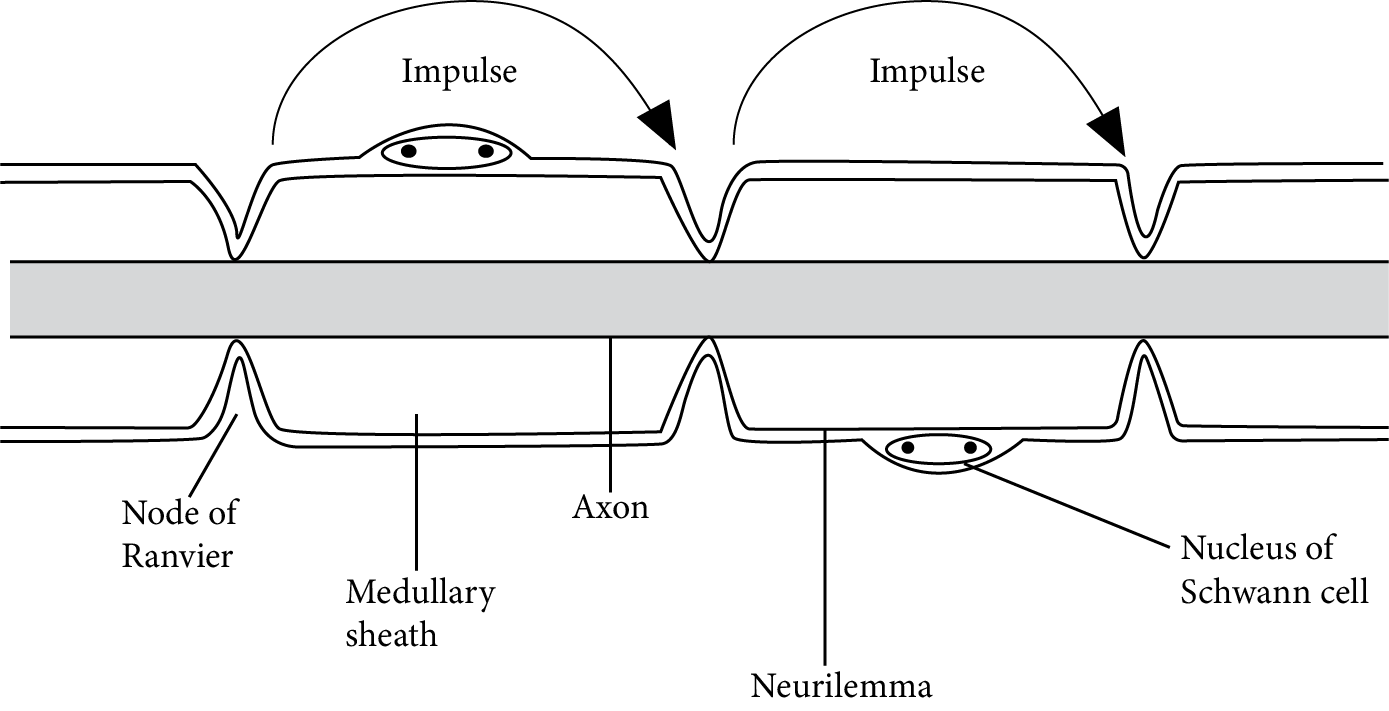
Saltatory Impulse of Nerve Conduction
The combined resistance of the axon membrane and myelin sheath is very high, but where breaks in the myelin sheath occur known as nodes of Ranvier, the resistance to current flow between the axoplasm and the fluid outside the cell is low. It is only at these nodes; that local circuits are set up.
This means, in effect, that the action potential jumps from node to node and passes along the myelinated axon faster as compared to the series of small local circuits in a non-myelinated axon. This type of conduction is called saltatory conduction. Leakage of ions takes place only in nodes of Ranvier and less energy is required for saltatory conduction.
Synapses
The term synapse was proposed by Charles Sherrington.
It is the junctional region between two neurons where information is transferred from one neuron to another neuron but has no protoplasmic connection.
Synapse = Pre synaptic knob + synaptic cleft + postsynaptic membrane
Synaptic Transmission
Neurons conduct the impulse in the form of electrochemical waves.
The conduction of nerve impulses is unidirectional.
It follows the all or none law.
The velocity of nerve impulse is directly proportional to the diameter of the neuron.
In mammals, the velocity of nerve impulse is 100 to 130 metres/sec.
This velocity is hampered by physical and chemical factors such as pressure, cold, heat, chloroform and ether etc.
Telodendria of one neuron form synapse with the dendron of the next neuron.
Telodendria membrane is called a presynaptic membrane and the membrane of the dendron of other neurons is called a postsynaptic membrane. The space between pre and postsynaptic membranes is called the synaptic cleft.
Synapses are of two types - electrical synapses and chemical synapses.
At electrical synapses, the membranes of pre-and postsynaptic neurons are very close by which electrical current easily flows from one neuron to the other. Impulse transmission across an electrical synapse is always faster than that across a chemical synapse. Electrical synapses are rare in our system.
At chemical synapses, the synaptic cleft is present. Chemicals called neurotransmitters are involved in the transmission of impulses at these synapses.
Neuroglia/Glial cells: These are supporting cells which form a packing substance around the neurons.
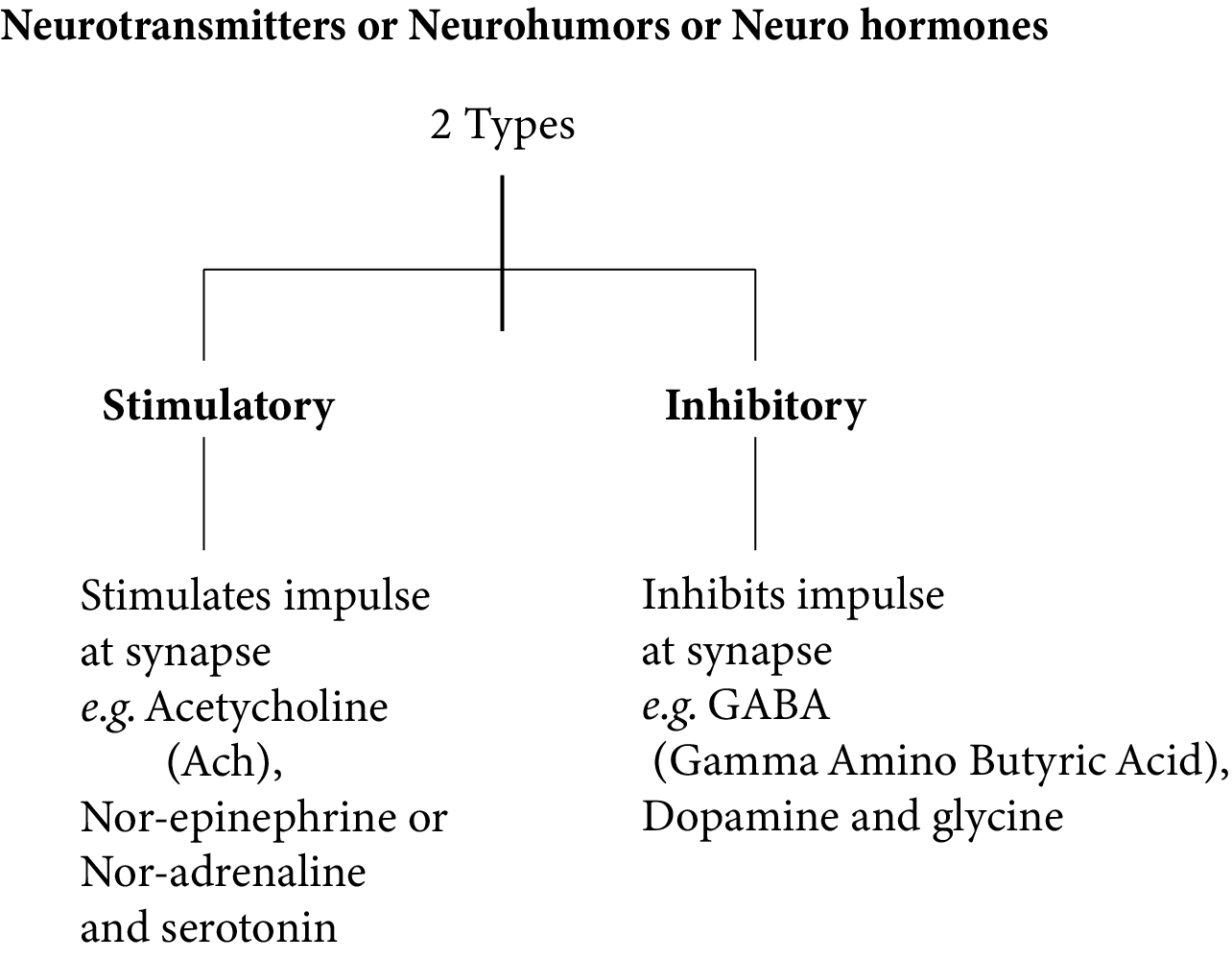
Neurotransmitters
Nervous System
It is the system which regulates the various activities of the body through nerve impulses by which the stimuli are transmitted at a faster rate.
The nervous system controls and coordinates the various activities of the organs of the animals.
The whole nervous system of human beings is derived from the embryonic ectoderm.
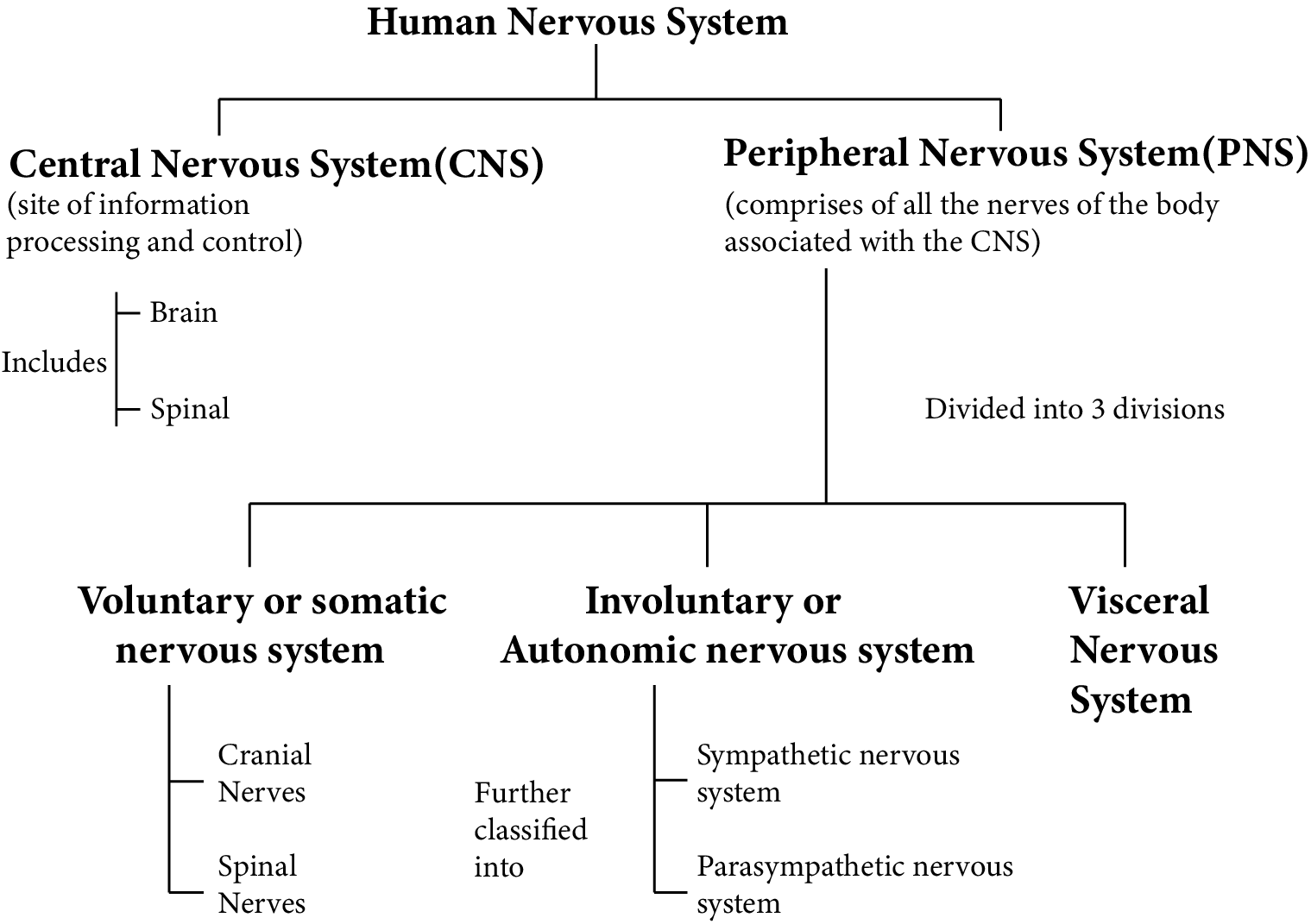
Human Nervous System
Central Nervous System
The brain is the central information processing organ of our body, and acts as the ‘command and control system’. It controls the voluntary movements, the balance of the body, functioning of vital involuntary organs (e.g., lungs, heart, kidneys, etc.), thermoregulation, hunger and thirst, circadian (24-hour) rhythms of our body, and activities of several endocrine glands and human behaviour. It is also the site for processing vision, hearing, speech, memory, intelligence, emotions and thoughts.
It includes the brain and the spinal cord. These are formed from the neural tube which develops from the ectoderm after the gastrula stage of the embryo.
Development of CNS: It develops from a neural tube. The anterior part of the neural tube develops into the brain while the caudal part of the neural tube develops into the spinal cord. Approximately 70-80% of the brain develops in 2 years of age & complete development is achieved in 6 years of age & spinal cord develops completely in 4 to 5 years of age.
Brain
It is situated in the cranial box of the skull which is made up of 8 bones which are: 1 frontal bone, 2 parietal bones, 2 temporal bones, 1 occipital bone, 1 ethmoid bone, and 1 sphenoid bone. The brain weight of an adult man is 1400 gm and of a female is 1250 gm.
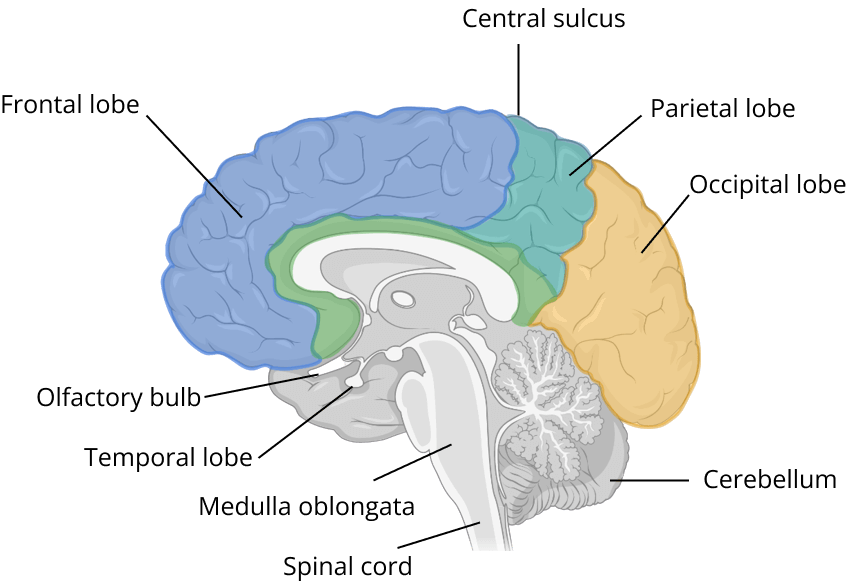
Human Brain
Brain Meninges
The brain is covered by three membranes of connective tissue termed meninges.
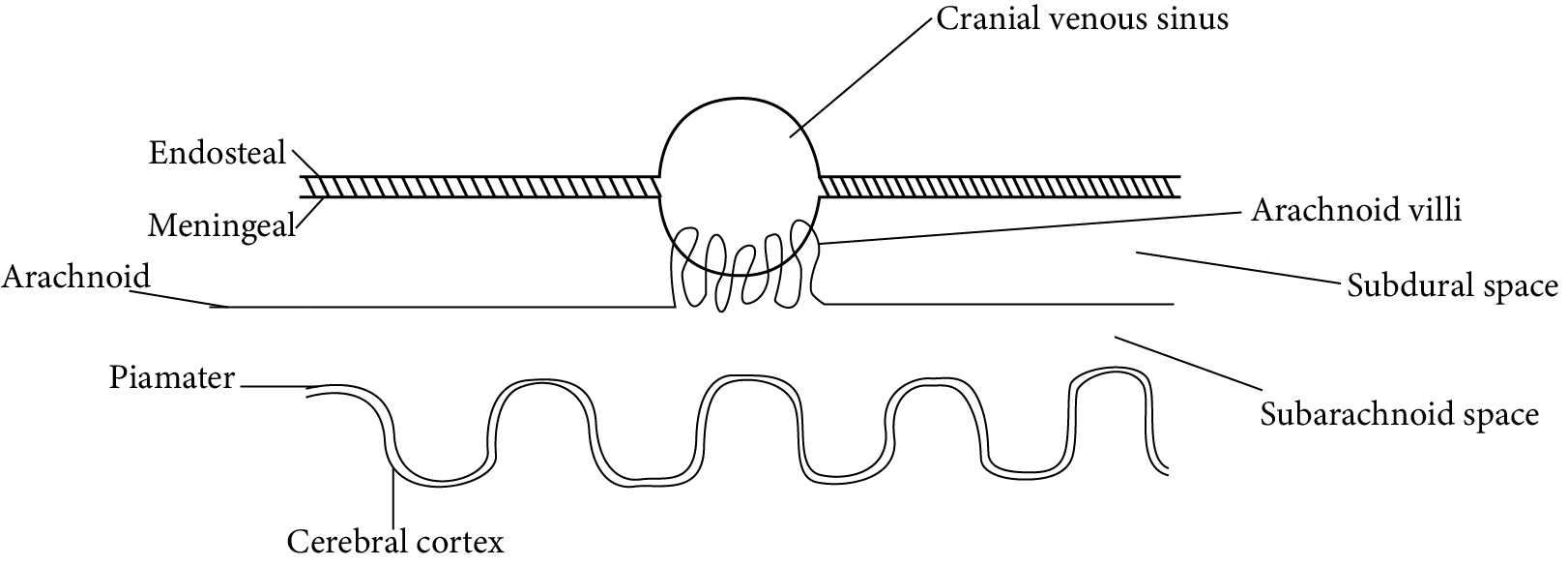
Different Meninges of the Human Brain
(1) Dura mater
This is the first and the outermost membrane and is thick, very strong and non-elastic. It is made up of collagen fibres. This membrane is attached to the innermost surface of the cranium.
It is a double layer-outer endosteal layer which is closely attached to most surfaces of the cranium & no space is found between the skull and dura mater (no epidural space). The inner meningeal layer which is related to other meninges of the brain, both are vascular. Generally, both layers are fused with each other, but in some places, these are separated from one another & form a sinus called a cranial venous sinus. These sinuses are filled with venous blood.
(2) Arachnoid
It is a middle, thin and delicate membrane. It is found only in mammals. It is a non-vascular layer. In front of the cranial venous sinus, it becomes folded, these folds are called arachnoid villi. These villi reabsorb the cerebrospinal fluid (CSF) from subarachnoid space & pour it into cranial venous sinuses.
(3) Pia mater
It is the innermost, thin and transparent membrane, made up of connective tissue. Dense networks of blood capillaries are found in it, so it is highly vascular.
It has firmly adhered to the brain. Pia mater & arachnoid layer at some places fuse together to form leptomeninges. Pia mater merges into the sulci of the brain & densely adheres to it. In some places, it directly merges in the brain and is called tela choroidea
Tela Choroidea makes the choroid plexus in the ventricles of the brain.
Subdural Space
Space between the dura mater & arachnoid. It is filled with serous fluid.
Subarachnoid Space
The space between the arachnoid & pia mater is filled with cerebrospinal fluid. S.F. cranial nerves also pass through this space.
Meningitis
Any inflammation of meninx is called meningitis. It may be caused by viruses, bacteria or protozoa.
Cerebrospinal Fluid (CSF)
This fluid is clear and alkaline in nature just like lymph. It has protein (albumin, globulin), glucose, cholesterol, urea, bicarbonates, sulphates and chlorides of Na and K. Protein & cholesterol concentration is lesser than plasma & Cl– concentration is higher than plasma.
In a healthy man, in 24 hrs, 500 ml of cerebrospinal fluid is formed & absorbed by arachnoid villi. At a time, the total volume of cerebrospinal fluid is 150 ml.
Cerebrospinal fluid is present in the ventricle of the brain, subarachnoid space of the brain & spinal cord.
Functions of CSF
It acts as a shock-absorbing medium and works as a cushion for the protection of the brain.
It provides buoyancy to the brain, so the net weight of the brain is reduced from about 1.4 kg to about 0.18 kg.
Excretion of waste products.
Endocrine medium for the brain to transport hormones to different areas of the brain.
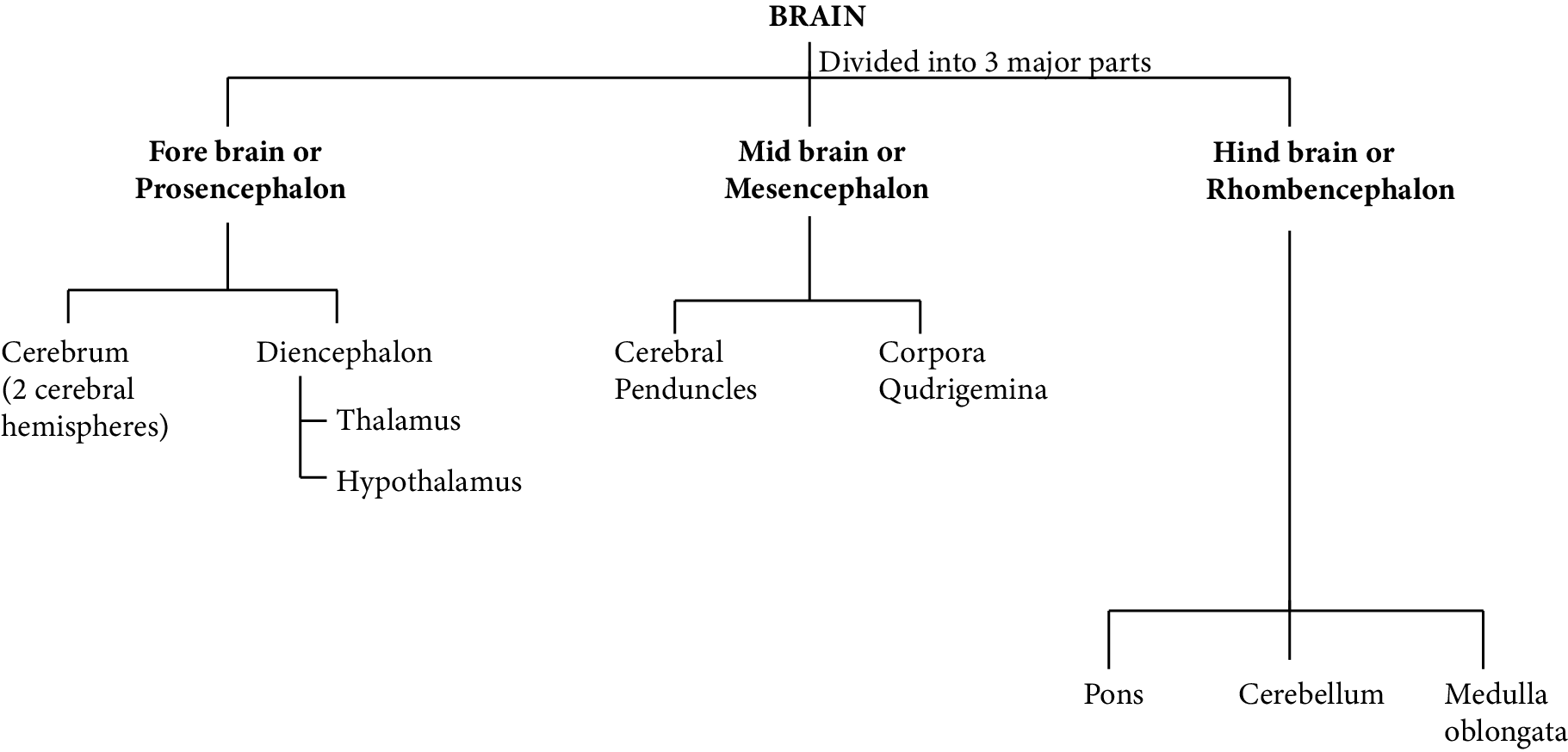
Classification of the Human Brain into Different Sections
(1) Forebrain
The forebrain consists of the cerebrum, thalamus and hypothalamus.
(a) Cerebrum
It is the first and most developed part of the brain. It makes up 2/3 part of the total brain.
The cerebrum consists of two cerebral hemispheres on the dorsal surface. Many ridges and grooves are found on the dorsal surface of the cerebral hemisphere. Ridges are known as gyri while grooves are called sulci. These cover the 2/3rd part of the cerebrum. Gyri and sulci are more developed in human beings so human beings are the most intelligent living beings. A longitudinal groove is present between two cerebral hemispheres called a median fissure. Both the cerebral hemispheres are partially connected with each other by curved thick nerve fibres called the corpus callosum.
The layers of cells which cover the cerebral hemisphere are called the cerebral cortex and are thrown into prominent folds. It is referred to as grey matter due to its greyish appearance. Inner to it is the cerebral medulla of white matter. Grey matter is made of cell bodies while white matter is formed of myelinated nerve fibres.
Temporal Lobes: Temporal lobes control hearing, smell, recall of audio-visual events and some components of speech.
Occipital Lobes: Occipital lobes have centres of perception of sight.
(b) Diencephalon
It is small and the posterior part of the forebrain. It is covered by the cerebrum. Its dorsal side is called the epithalamus in which the pineal body is situated, which controls the sexual maturity of the animal.
It consists of the thalamus and hypothalamus.
Thalamus
It forms the upper lateral walls of the diencephalon. It forms 80% part of the diencephalon.
It acts as a relay centre. It receives all sensory impulses from all parts of the body & these impulses are sent to the cerebral cortex.
Hypothalamus
It forms the lower lateral wall of the diencephalon.
A cross-like structure is found on the anterior surface of the hypothalamus called the optic chiasma. It carries optic impulses received from the eyes to the cerebral hemispheres. Animals become blind if this part is destroyed by chance.
The pituitary body is attached to the middle part of the hypothalamus by the infundibulum.
Corpus mamillare or Corpus Albicans is found on the posterior part of the hypothalamus. It is a characteristic of the mammalian brain.
Hypothalamus has control centres for hunger, thirst, fatigue, sleep, sweating, body temperature and emotions. It also secretes a number of hormones.
The inner parts of cerebral hemispheres and a group of associated deep structures like the amygdala, hippocampus, etc., form a complex structure called the limbic lobe or limbic system. Along with the hypothalamus, it is involved in the regulation of sexual behaviour, expression of emotional reactions (e.g., excitement, pleasure, rage and fear), and motivation.
(2) Midbrain
It is located between the thalamus/hypothalamus of the forebrain and pons of the hindbrain.
The anterior part of the midbrain contains two longitudinal myelinated nerve fibres called cerebral peduncles or crura cerebri.
Crura cerebri controls the muscles of limbs.
On the posterior part of the midbrain are found four spherical projections called colliculus or optic lobes. Four colliculi are collectively called corpora quadrigemina (2 uppers and 2 lower).
(3) Hindbrain
It comprises the pons, cerebellum and medulla oblongata.
(a) Pons or Pons varolii
It is a small spherical projection, which is situated below the midbrain and upper side of the medulla oblongata.
Pons function as relay centres among different parts of the brain. It also possesses a pneumotaxic area of the respiratory centre.
(b) Cerebellum
It is made up of 3 lobes [2 lateral lobes and 1 vermis (divide into 9 segments)].
It is the second largest part of the brain, constituting about 12.5% of the total volume of the brain. It lies behind the cerebrum and above the medulla oblongata.
(c) Medulla Oblongata
It is the hindmost part of the brain which lies below the cerebellum. It continues behind into the spinal cord. Medulla oblongata has a fluid-filled cavity called the fourth ventricle. Its roof bears posterior choroid plexus (for filtering cerebrospinal fluid from blood) and three pores for connecting external cerebrospinal fluid with internal cerebrospinal fluid. The medulla oblongata contains –
Respiratory centre for regulating the rate of breathing.
Cardiac centre for regulating the rate of heartbeat.
Regulation of blood pressure.
Reflex centre for swallowing, vomiting, coughing, sneezing, salivation etc.
Pons, medulla oblongata and midbrain are collectively called the brain stem.
Internal Structure of Brain
One pair of small, spherical and solid olfactory lobes are present in the human brain. No ventricle is found in it. Both olfactory lobes are separate from each other & are embedded into the ventral surface of both frontal lobes of the cerebral hemisphere.
The olfactory lobe is supposed to be the centre of smelling power. Its size is small in mammals comparatively because most of its parts become a part of the cerebrum. Some animals like sharks and dogs have well-developed olfactory lobes.
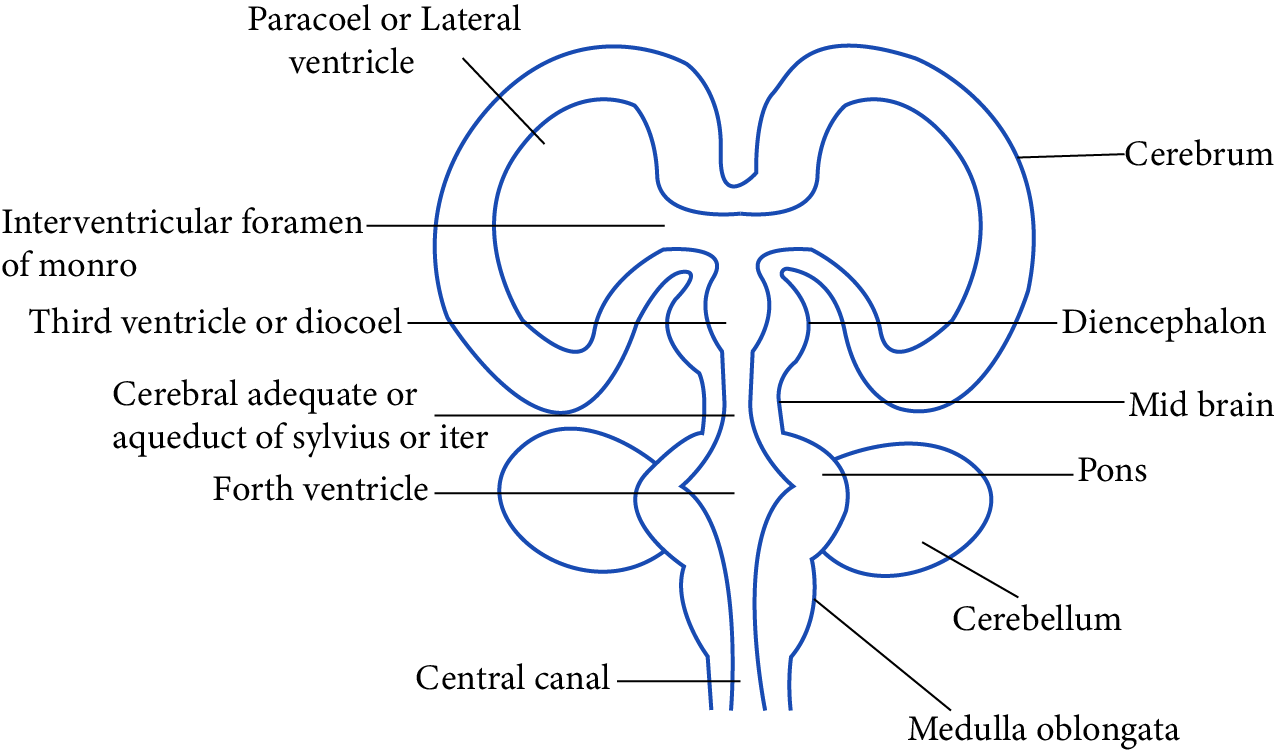
Longitudinal Section of Human Brain
Except for the midbrain, cerebellum, pons & olfactory lobe, the complete brain is internally hollow. Its cavity is lined by ependymal epithelium (ciliated columnar epithelium).
Cavities of the brain are known as ventricles, filled with cerebrospinal fluid (CSF).
Function: Formation of CSF by secretion of plasma.
Basal Ganglia
These consist of two main structures, the corpus striatum (the biggest nucleus of basal ganglia) and the red nucleus.
The Corpus striatum is further differentiated into the Lenticular nucleus and Caudate nucleus.
The Lenticular nucleus contains 2-parts, the pallidus and putamen.
Functions
It maintains muscle tone.
It regulates automatically associated movements like swinging of arms during walking.
In lower animals, when the cerebral cortex is not developed basal nuclei act as the motor centre.
Parkinson’s disease (shaking palsy) develops due to the deficiency of a neurotransmitter (Dopamine) in a part of the basal ganglia.
Limbic System
It is visible like a wishbone, tuning fork or lip like the neural link between the cerebrum and brainstem.
It includes limbic lobes (area of the temporal lobe), hippocampus, hypothalamus including the septum, part of thalamus and amygdaloid complex.
Functions of Limbic System
It converts behaviour, emotion, rage and anger (hypothalamus, amygdaloid body).
It converts recent memory and short-term memory into long-term memory. (Hippocampal lobe).
Functions of Brain
Sensory Information: The brain receives information from all the sensory receptors and sense organs of the body.
Processing: It processes the information obtained from various sources and chooses the most appropriate response.
Response: The brain sends instructions to effector organs all over the body to provide the appropriate response to received stimuli.
Control: It has controls for regulating the functioning of various body organs.
Coordination: The working of the different organs of a system is coordinated by the brain.
Reflexes: It has centres for reflexes related to sound, sight and involuntary functioning of many body parts.
Spinal Cord
The spinal cord is a long, thin tubular bundle of nervous tissue and support cells that extends from the brain (the medulla oblongata specifically).
The spinal cord begins at the occipital bone and extends down to the space between the first and second lumbar vertebrae; it does not extend the entire length of the vertebral column.
Its upper part is wide while the lowermost part is narrow, known as conus-medullaris.
Conus medullaris is present up to the L1 vertebra. The terminal part of the conus medullaris extends in the form of a thread-like structure made up of fibrous connective tissue called filum terminale.
The spinal cord is protected by 3 layers of tissue, called spinal meninges, that surround the canal.
The dura mater is the outermost layer, and it forms a tough protective coating. Between the dura mater and the surrounding bone of the vertebrae is a space called the epidural space.
The arachnoid mater is the middle protective layer.
The pia mater is the innermost protective layer. It is very delicate and it is tightly associated with the surface of the spinal cord.
The outer part of the spinal cord is of white matter while the inner part contains grey matter.
On the dorsolateral & ventrolateral surface of the spinal cord, the grey matter projects outside & forms one pair of dorsal & ventral horns.
Due to the formation of dorsal & ventral horns, white matter is divided into 4 segments and this segment is known as funiculus or white column.
The spinal cord has 3 major functions: as a conduit for motor information which travels down the spinal cord, as a conduit for sensory information in the reverse direction and finally as a centre for coordinating certain reflexes.
Peripheral Nervous System
All the nerves arising from the brain and spinal cord are included in the peripheral nervous system.
Nerves arising from the brain are called cranial nerves, and nerves coming out of the spinal cord are called spinal nerves.
The nerve fibres of the PNS are of two types :
Afferent fibres: These transmit impulses from tissues/organs to the central nervous system (CNS).
Efferent fibres: These transmit regulatory impulses from the CNS to the concerned peripheral tissues/organs.
The peripheral nervous system (PNS) is divided into 3 divisions –
Somatic nervous system (SoNS) or Voluntary nervous system
Autonomic nervous system (ANS)
Visceral nervous system (VNS)
Somatic Nervous System
It is associated with the voluntary control of body movements via skeletal muscles. The SoNS consists of different nerves responsible for stimulating muscle contraction, including all the non-sensory neurons connected with skeletal muscles and skin.
It consists of three parts :
Cranial nerves
Spinal nerves
Association Nerves
(1) Cranial Nerves
12-pairs of cranial nerves are found in reptiles, birds and mammals but amphibians and fishes have only 10 pairs of cranial nerves.
In humans, I, II and VIII are cranial nerves out of 12 pairs total, cranial nerves are pure sensory in nature.
III, IV, VI, XI and XII cranial nerves are motor nerves and V, VII, IX & X cranial nerves are mixed types of nerves.
Fibres of the autonomic nervous system are found in the III, VII, IX & X cranial nerves.
The longest cranial nerve is the Vagus nerve.
The largest cranial nerve is the Trigeminal nerve.
The smallest cranial nerve is the Abducens nerve.
(2) Spinal Nerves
In rabbits, there are 37 pairs of spinal nerves, while in frogs there are 9 or 10 pairs of spinal nerves.
In humans, only 31 pairs of spinal nerves are found.
The spinal nerves in man are divided into 5 groups.
(1) Cervical (C) → 8 pairs — in the neck region
(2) Thoracic (T) → 12 pairs — in the thoracic region
(3) Lumbar (L) → 05 pairs — upper part of the abdomen
(4) Sacral (S) → 05 pairs — the lower part of the abdomen
(5) Coccygeal (CO) → 01 pair — represent the tail nerves.
Total = 31 pairs
Each spinal nerve is a mixed type and arises from the roots of the horns of the grey matter of the spinal cord. In the dorsal root, only afferent or sensory fibres and in the ventral root efferent or motor fibres are found.
Both the roots after moving for distance in the spinal cord of vertebrates combine with each other and come out from the intervertebral foramen in the form of spinal nerves.
(3) Associated Nerves
These nerves integrate sensory input and motor output.
Autonomic Nervous System
The autonomic nervous system is that part of the peripheral nervous system which controls activities inside the body that are normally involuntary, such as heartbeat, gut peristalsis, sweating etc.
It consists of motor neurons passing to the smooth muscles of internal organs. Smooth muscles are involuntary muscles. Most of the activities of the autonomic nervous system are controlled within the spinal cord or brain by reflexes known as visceral reflexes and do not involve the conscious control of higher centres of the brain.
Overall control of the autonomic nervous system is maintained, however, by centres in the medulla (a part of the hindbrain) and hypothalamus.
ANS plays an important role in maintaining the constant internal environment (homeostasis).
There are two divisions of the autonomic nervous system: the sympathetic (SNS) nervous system and the parasympathetic (PNS) nervous system.
Sympathetic and parasympathetic divisions typically function in opposition to each other. But this opposition is better termed complementary in nature rather than antagonistic. The sympathetic division typically functions in actions requiring quick responses. The parasympathetic division functions with actions that do not require immediate reaction. Consider sympathetic as "fight or flight" and parasympathetic as "rest and digest" or "feed and breed".
Visceral Nervous System
The visceral nervous system is the part of the peripheral nervous system that comprises the whole complex of nerves, fibres, ganglia and plexuses by which impulses travel from the central nervous system to the viscera and from the viscera to the central nervous system.
Reflex Action
Marshal Hall first observed the reflex actions.
Reflex actions are spontaneous, automatic, involuntary, mechanical responses produced by specific stimulating receptors.
It is a form of animal behaviour in which the stimulation of a sensory organ (receptor) results in the activity of some organs without the intervention of will.
Reflex actions are of 2 types:
Cranial reflex: These actions are completed by the brain. No urgency is required for these actions. These are slow actions, e.g., watering of mouth to see good food.
Spinal reflex: These actions are completed by the spinal cord. Urgency is required for these actions. These are very fast actions, e.g., displacement of the leg at the time of pinching by any needle.
Classification of reflex actions on the basis of previous experiences:
Conditioned reflex: Previous experience is required to complete these actions e.g., swimming, cycling, dancing, singing etc. These actions were studied first by Evan Pavlov on dogs. Initially, these actions are voluntary at the time of learning and after perfection these become involuntary.
Unconditioned reflex: These actions do not require previous experience, e.g., sneezing, coughing, yawning, sexual behaviour for opposite-sex partners, migration in birds etc.
Reflex Arc:
The path of completion of reflex action is called a reflex arc.
Sensory fibres carry sensory impulses in the grey matter. These sensory impulses are converted now into motor impulses and reach up to muscles. These muscles show reflex actions for motor impulses obtained from motor neurons. The reflex arc is of two types :
Monosynaptic: In this type of reflex arc, there occurs a direct synapse (relation) between sensory and motor neurons. Thus, the nerve impulse travels through only one synapse, e.g., the Stretch reflex
Polysynaptic: In this type of reflex arc, there are one or more small neurons in between the sensory and motor neurons. These small neurons are called connectors or interneurons, e.g., withdrawal reflex. Nerve impulses will have to travel through more than one synapse in this reflex arc.
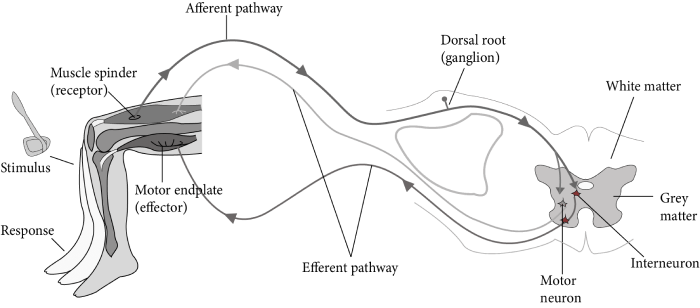
Diagram of Reflex Action
Sensory reception and Perception:
A sensory system is a part of the nervous system responsible for processing sensory information. A sensory system consists of sensory receptors, neural pathways, and parts of the brain involved in sensory perception.
We smell things by the nose, taste by the tongue, hear by ear and see objects by eyes.
The sense receptors on the tongue and within the nasal cavity work very closely together to give us our sense of taste. These 5 kinds of receptors-the olfactory cells in the nose and the four special cells or taste buds (gustatory receptors) on the tongue for discriminating salty, sweet, sour, and bitter tastes also have a functional similarity. The neurons of the olfactory epithelium extend from the outside environment directly into a pair of broad bean-sized organs, called the olfactory bulb, which are extensions of the brain's limbic system.
Human eye:
The human eye has a photoreceptor organ (photoreceptor part-retina)
It is ecto-mesodermal in origin.
The wall of the eyeball is composed of three layers; i.e., scleroid, choroid and retina.
1. Scleroid: It consists of white fibrous connective tissue, and therefore, looks white. The anterior one-sixth part of the eyeball, visible externally, is transparent and is called the cornea. The major part (5/6) of the eyeball is white.
2. Choroid
It is a pigmented and highly vascularised coating.
Unlike scleroid, it is incomplete in the anterior region and forms ciliary bodies and iris.
The pupil (an opening for light entry) is present in the centre of the iris. The eye colour is the colour of the iris.
The ciliary body secretes aqueous humour which provides nourishment to the lens and cornea because these do not have a blood supply of their own. The 2-chambers which contain aqueous humour are the anterior (between the cornea and iris) and posterior (between iris and lens) chambers.
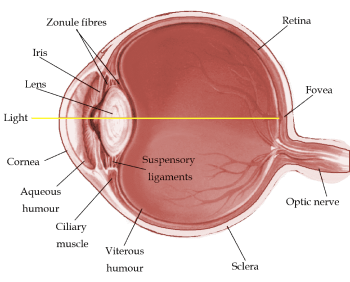
Vertical Section of the Mammalian Eye.
3. Lens
The lens in the human eye is biconvex, circular, living, multi-cellular and non-vascularised (no blood supply).
It is purely ectodermal in origin.
The position of the lens in humans is fixed but the focal length is adjustable. This adjustment of the focal length by thinning or thickening of the lens is called accommodation power.
The focal length (f) of a human eye lens is 1.5 cm, with refractive power of 66.7 Diopter at rest.
4. Retina
It is a sensory coating of the eye.
In the human eye, the retina is inverted in nature.
From outer to inner, the retina has 4 prominent layers –
(i) Pigmented epithelium (ii) Sensory layer (iii) Bipolar neurons layer (iv) Ganglionic layer with optic nerve fibres.
The pigmented epithelium absorbs scattered light rays to prevent internal reflection.
The sensory layer has two types of sensory cells –
(i) Rods (ii) Cones
In each human eye, the number of rods (~120 million) is 20 times that of cones.
The yellow spot at the visual axis of the retina is called the macula lutea. This contains only cones. The sharpest vision occurs at the central concave point of the yellow spot called fovea centralis.
The point from where the optic nerve arises is called a blind spot. As Both rods and cones are absent at this point and therefore, there is no vision.
The rods are sensitive to vision in dim light (for black & white vision). Night vision (i.e., vision in dim light) is also called ‘scotopic vision.
The pigment present in rods is rhodopsin.
The cones are sensitive to bright light. The colour vision is called photopic vision.
The pigment present in cones is called photopsin.
Between the retina and lens, there is a jelly-like mucous connective tissue, called the vitreous humour. It is a permanent refractive medium and maintains the shape of the eyeball.
○ The image formed on the retina of the human eye is laterally inverted and is reversed.
Mechanism of Vision
● The light rays from the object pass through the conjunctiva, cornea, aqueous humour, lens and vitreous humour in that order. All these structures refract the light such that it falls on the retina. This is called focussing. Maximum focusing is done by the cornea and the lens. The light then falls on the retina.
● This light is received by the photoreceptors-rods and cones on the retina. The absorbed light activates the pigments present in the rods and cones. The pigments are present on the membranes of the vesicles. Thus, the light is then converted into action potentials in the membranes of the vesicles. These travel as nervous impulses through the rod or cone cell and reach the synaptic knobs. From here the impulses are transmitted to the bipolar nerve cells, then to the ganglions and then to the optic nerves.
Refractive error of the eye
● Myopia: In this defect, the image is formed in front of the retina and far objects are not clearly seen.
Reason - The increased curvature of the cornea or increased convexity of the lens.
Prevention - By biconcave (diverging) lens myopia can be corrected.
● Hypermetropia: In this, the image is formed behind the retina. So near objects are not seen clearly.
Reason - In this, the lens becomes flat or decreased curvature of the cornea decreases convexity of the lens. The eye of a newborn baby is "hypermetropic".
Prevention - It is corrected by a biconvex (converging) lens.
● Presbyopia: Hypermetropia occurs at the age of around 35 to 40 years, as in this defect the elasticity of the lens decreases, so hypermetropia occurs. Hypermetropia due to ageing is called presbyopia and is further Corrected by the biconvex lens.
● Astigmatism: Due to different curvatures of the lens at the different places the overall image is not formed at the yellow spot. Cylindrical lenses are used for the correction of this disorder.
Other diseases of the eye
● Cataract: The lenses of the eyes become opaque after the age of 60 and this happens basically due to the destruction of cysteine and glutathione amino acids. In India, it is the most common cause of blindness (80%).
Treatment: Removal of cataract lens which further is replaced by an intraocular lens.
● Glaucoma: At the junction of cornea and sclera, there is a canal called Schlemmer's canal. This canal drains out aqueous humour into the veins. Aqueous humour is formed by the blood vessels of the ciliary process. Sometimes Schlemm canal gets blocked, so drainage of aqueous humour does not occur. Hence, aqueous humour gets collected in the anterior and posterior chambers of the eye. So IOP (Intraocular pressure) increases (normally 16-23 mm of Hg) and the condition is called Glaucoma.
● Trachoma: It is an infectious disease caused by Chlamydia trachomatis bacteria which produces a characteristic roughening of the inner surface of the eyelids. Occurring inflammation of the conjunctiva is called conjunctivitis. Eyes become red.
Human Ear
● It is a statoacoustic organ, i.e., for balancing as well as hearing.
● Human ear has 3 parts –
1. External ear – Pinna + Auditory meatus
2. Middle ear – Tympanic cavity + ear ossicles
3. Internal ear – Vestibular apparatus + cochlea.
● Between the external and middle ear, an ear drum (Tympanum) is present. Similarly, between the middle ear and internal ear, there are two membrane-bound windows – the oval window (Fenestra ovalis) and the round window (Fenestra rotundus) are present.
1. External Ear:
Pinna (Auricula), a characteristic of mammals, directs sound vibrations towards auditory meatus. It is made up of elastic cartilage.
Ceruminous glands are present in the lining of the auditory meatus and secrete ear wax (Cerumen). The ear wax is sticky and prevents the entry of dust particles into the tympanum. It also prevents fungal and bacterial infections.
2. Middle Ear:
The cavity of the middle ear is called the tympanic cavity. It develops from pharyngeal out-growth and is, therefore, endodermal in origin.
Eustachian tubes connect the middle ear to the pharynx and prevent the rupturing of the tympanum during louder sound by equalising the pressure on the back of the membrane. The Eustachian tubes open during yawning, swallowing and chewing.
The tympanic cavity contains 3-ear ossicles (smaller bones). From the tympanum to the oval window, the sequence of these bones is –
■ Malleus – Hammer shaped
■ TIncus – Anvil shaped
■ Stapes – Stirrup shaped
The ear ossicles not only conduct sound vibrations but also amplify them.
Stapes, the smallest bone of a mammalian body, fit onto the oval window.
3. Internal Ear:
The oval window is the inlet for the sound vibrations. Because of the smaller size of the oval window, the pressure of sound is also amplified on this membrane by about 20 times the pressure on the tympanum.
The sensory part of the internal ear is called the membranous labyrinth. It is filled with Endolymph.
The membranous labyrinth is surrounded by a bony labyrinth, formed by ‘Temporal bone’. Between membranous labyrinth and bony labyrinth, the fluid is Perilymph.
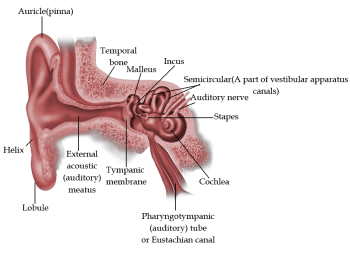
Structure of Ear
Mechanism of Hearing
The primary step is that Pinna collects the sound waves and amplification of sound waves is also done and then it is passed along the auditory canal to the eardrum.
Sound waves strike the eardrum and cause vibrations in the stretched membrane. The eustachian tube balances the air pressure on either side of the eardrum which allows a free vibration.
The vibration furthermore reaches the ear ossicles in the middle ear which then transmit vibrations from the air to the denser fluid in the ear.
The lever-like action of malleus and incus magnifies the vibration of the stapes.
The vibrating stapes transmit vibrations to the membrane of the oval window. A round window reduces the movement of fluid in the cochlea.
Vibrations from the oval window transmit to the cochlea. This leads to vibration of the fluid in the cochlear canals.
Vibrations of fluid in cochlear canals trigger movement of hair cells of the organ of Corti in the cochlea.
Movement of hair cells is converted to a nerve signal.
Nerve signal is transmitted to the brain via the auditory nerve and thus this results in hearing.
Points to remember
The neural system coordinates and integrates functions as well as metabolic and homeostatic activities of all the organs.
Neurons, the functional units of the neural system, are excitable cells due to a differential concentration gradient of ions across the membrane.
The electrical potential difference across the resting neural membrane is called the 'resting potential'.
The nerve impulse is conducted along the axon membrane in the form of a wave of depolarisation and repolarisation.
A synapse is formed by the membranes of a presynaptic neuron and a postsynaptic neuron which may or may not be separated by a gap called the synaptic cleft.
Chemicals involved in the transmission of impulses at chemical synapses are called neurotransmitters.
The human neural system consists of two parts : (i) the central neural system (CNS) and (ii) the peripheral neural system.
The human eye ball's wall is made up of three layers. The cornea and sclera make up the external layer.
The middle layer of the sclera is known as the choroid.
The innermost layer, the retina, includes two types of photoreceptor cells: rods and cones. Cones are responsible for daylight (photopic) and colour vision, while rods are responsible for twilight (scotopic) vision.
Light enters the eye through the cornea and the lens, and images of objects are created on the retina.
The ear is divided into three sections: the outer ear, the middle ear, and the inner ear.
The malleus, incus, and stapes ossicles are located in the middle ear.
The labyrinth is the fluid-filled inner ear, and the cochlea is the coiled component of the labyrinth.
The organ of Corti is a component on the basilar membrane that incorporates hair cells that behave as auditory receptors.
The vibrations created in the eardrum are forwarded to the fluid-filled inner ear via the ear ossicles and oval window.
Nerve signals are produced and conveyed to the brain's auditory cortex via afferent fibres.
The vestibular apparatus is a complex system situated above the cochlea in the inner ear. It is impacted by gravity and motions and aids us in maintaining body balance and posture.
Importance of Neural Control and Coordination Notes
If you hate making notes or are not just good at it, downloading the Neural Control and Coordination notes for NEET PDF would be a better option for you. It will give you an edge when on your preparation and make you less worried about the exams. Here’s why downloading the Neural Control and Coordination notes PDF is important:
You can easily answer the textbook question by revising the notes.
You won’t need help from tutors as all the matters in this note have been explained in simple language and thoroughly.
The Neural Control and Coordination notes PDF available on our website contain bullet points, well-articulated explanations, and activities. All of these will help you get the concept in a better and much simpler way. As a result, you can remember all the topics of the chapter very well.
Important Topics of Class 11 Biology Neural Control and Coordination
Neural Control and Coordination is an important topic explaining human physiology. The nervous system, which is made up of neurons, is very important. One needs to grasp all of the fundamental and functioning aspects of the nervous system, including neuron categorization and to perform well in the tests. This topic is also thoroughly covered in our detailed Neural Control and Coordination Class 11 notes.
Some Important Topics of this Chapter
If you are too confused about the chapter, here are some of the important topics to get you started.
What iso hormones do?
How do hormones work?
Chemical Coordination and Integration
Central Nervous System
Autonomic Nervous System
Conduction of Nerve Impulse
Start with these, and then you can progress with the rest of the Neural Control and Coordination notes.
Benefits of Choosing Vedantu’s Revision Notes for NEET PDF
The sole reason experts have crafted these Neural Control and Coordination revision notes is to help the students. Some students might find this chapter hard to comprehend, and for those students, this PDF can work like a charm. There are several benefits of these notes, here are only a few of those:
Only subject experts helped create these notes, so expect nothing but simplified solutions to all your queries.
You can practice textbook question answers and learn the concepts better to score higher in the NEET exam.
The Neural Control and Coordination NEET notes also have basic tricks and tips as well as extra practice material so that students can ace the exam.
Students who dislike making notes can especially take advantage of the notes.
You won’t have to find a tutor.
Students will feel more at ease when giving the exam as these notes help them understand the question pattern.
Conclusion
Therefore, the Neural Control and Coordination notes PDF from Vedantu is the best tool to get a higher rank in the NEET exam. Since Vedantu’s subject matter experts write these revision notes, you can follow them without any worries. Download the PDF now to crack the NEET Biology exam.
NEET Biology Revision Notes - Chapter Pages
NEET Biology Chapter-wise Revision Notes | |
Neural Control and Coordination Notes | |
Other Important Links
Other Important Links for NEET Neural Control and Coordination |
FAQs on Neural Control and Coordination NEET Notes 2025
1. Can I get Neural Control and Coordination notes online?
Yes, at Vedantu, you can find the best Neural Control and Coordination revision notes to ace the NEET exam.
2. How many questions come from Neural Control and Coordination chapter in NEET?
A total of 125 questions come from class 11 Biology Chapter 21 Neural Control and Coordination.
3. Is Neural Control and Coordination important for NEET?
Yes. The Control and Coordination chapter includes most of the crucial concepts that frequently appear in the NEET exam.
4. How to prepare well with the neural control and coordination class 11 notes?
To prepare well for this chapter, practise the questionnaire and revise the solutions and important points given in the notes.



















